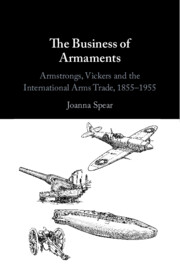Book contents
- The Business of Armaments
- The Business of Armaments
- Copyright page
- Dedication
- Contents
- Figures and Tables
- Acknowledgments
- Abbreviations
- Figures
- Introduction
- Part I Selling at Home
- 1 Armstrongs and Vickers Become Armament Firms
- 2 Selling Armaments in Britain 1860–1900
- 3 Selling Armaments in Britain 1901–1918
- 4 Selling Armaments in Britain 1919–1935
- 5 Selling Armaments in Britain 1936–1955
- Part II Selling Abroad
- Conclusions
- Bibliography
- Index
2 - Selling Armaments in Britain 1860–1900
Armstrongs Rises and Vickers Evolves
from Part I - Selling at Home
Published online by Cambridge University Press: 19 January 2023
- The Business of Armaments
- The Business of Armaments
- Copyright page
- Dedication
- Contents
- Figures and Tables
- Acknowledgments
- Abbreviations
- Figures
- Introduction
- Part I Selling at Home
- 1 Armstrongs and Vickers Become Armament Firms
- 2 Selling Armaments in Britain 1860–1900
- 3 Selling Armaments in Britain 1901–1918
- 4 Selling Armaments in Britain 1919–1935
- 5 Selling Armaments in Britain 1936–1955
- Part II Selling Abroad
- Conclusions
- Bibliography
- Index
Summary
With Sir William Armstrong modernizing the Woolwich Arsenal, his colleagues formed the Elswick Ordnance Company to manufacture Armstrongs Guns exclusively for the government. When Woolwich could manufacture the guns itself, Elswick’s contract was canceled. Sir William resigned and returned to Newcastle and Sir W. G. Armstrong & Co. was formed. Denied domestic orders, the new firm began selling abroad, facilitated by the Armstrong Gun’s reputation. Armstrongs developed the Staunch gunboat to carry their guns and moved from muzzle-loading to breech-loading guns. Armstrongs generated sales around the world, enabling the firm to survive a seventeen-year domestic order drought. Talent at Armstrongs was now sought out by the Admiralty, and personnel exchanges began. Armstrongs was the dominant British player in the armaments market until the 1880s, when Vickers emerged as a challenger. Vickers built its steel business, and developed new products and an entrepreneurial culture. Vickers successfully moved into producing marine propellers, steel for guns, and then armor, winning government contracts. Vickers then bought Maxim Nordenfelt and the Naval Construction & Armaments Company of Barrow, giving it the ability to build complete battleships. Now both Armstrongs and Vickers were engaged in complex negotiations with the government over their patents and royalties.
- Type
- Chapter
- Information
- The Business of ArmamentsArmstrongs, Vickers and the International Arms Trade, 1855–1955, pp. 37 - 80Publisher: Cambridge University PressPrint publication year: 2023

